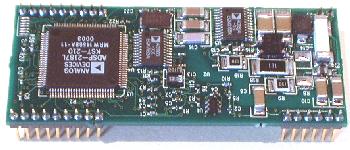Analog Devices debuts single-chip “Internet Modem”
Oct 3, 2000 — by Rick Lehrbaum — from the LinuxDevices Archive — 1 viewsBack in the late 70's, the big story in embedded electronics was about programmed microprocessors replacing dedicated logic controllers. “Firmware” was beginning to replace “hard-wired logic” in all sorts of automated systems. The chips that fueled that process were first the 4004, 8008, and 8080 microprocessors, and later the 6502, 8051, and 68HC11 microcontrollers.
Two decades later, embedded microcomputers are now commonplace and there is a new scent of change in the air — digital signal processors (DSPs) are replacing microcontrollers and dedicated single-chip controllers for all sorts of low level tasks. One of the most common examples is in the area of DSP-based modems, because the approach enables a convenient means to accomodate continually evolving modem protocols. The idea is this: all you need to do to upgrade to a new, higher speed modem standard is alter the DSP's internal software by downloading an upgrade from the web.
Analog Devices, one of the leading providers of DSP technology, with assistance from eDevice, has now taken the DSP Modem one step further by squeezing a TCP/IP protocol stack into the DSP's control software along with all the usual modem functions. The result: a single-chip “Internet Modem” which supports modem protocols ranging from V.32bis (14K bps) up to V.90 (56K bps) — plus the ability to communicate directly with other Internet devices via TCP/IP, PPP, SMP, POP3, FTP, Telnet, and other common protocols — all managed directly by the DSP chip itself, without assistance from any other computer.
To be precise, the Analog Devices Internet Modem isn't exactly a single-chip solution. To create a complete working modem, you also need a two-chip DAA, plus a means to load the required control software into the DSP chip's internal RAM. That software can be loaded automatically from an external EPROM or Flash chip — or it can be transfered from another processor within the system, if one is available. In addition to the three or four active components (DSP, 2-chip DAA, optional EPROM), you'll also need a handful of passive components (resistors and capacitors). Analog Devices has priced the ADSST-218X based Internet Modem chipset, including its control software, at $18.50 in quantities of 10,000+.

This article was originally published on LinuxDevices.com and has been donated to the open source community by QuinStreet Inc. Please visit LinuxToday.com for up-to-date news and articles about Linux and open source.